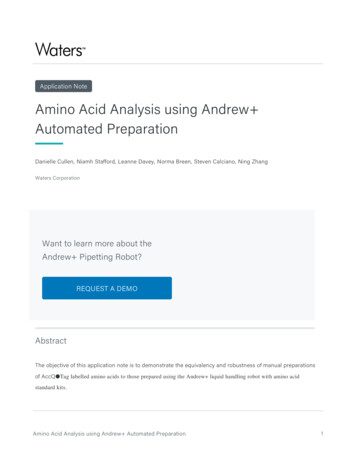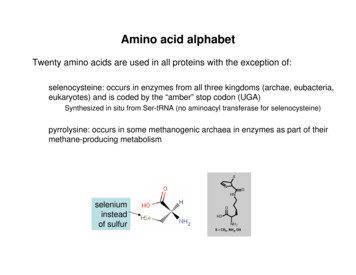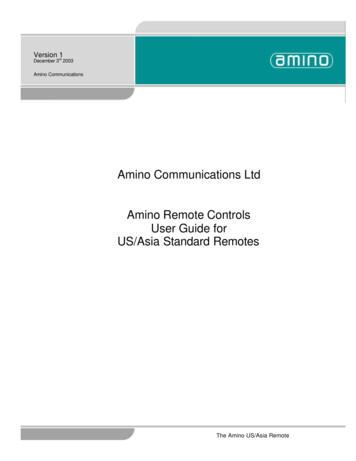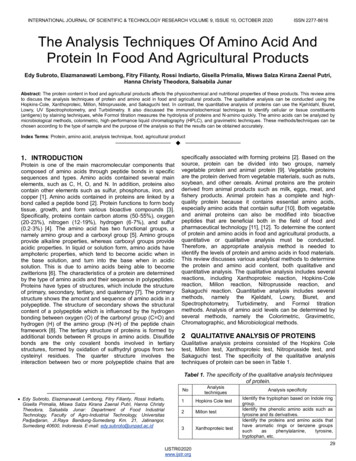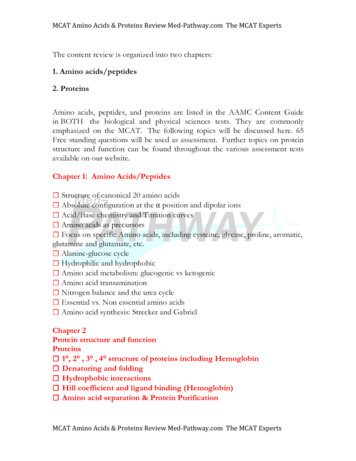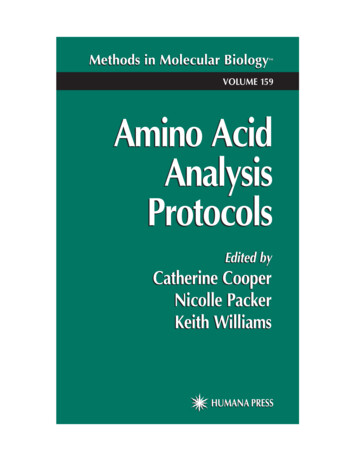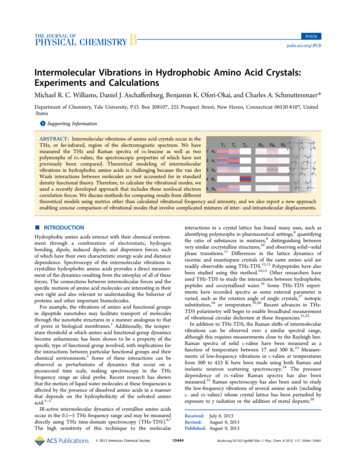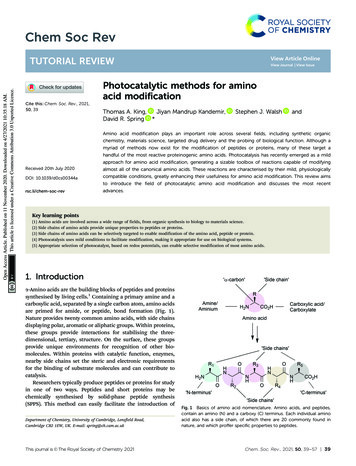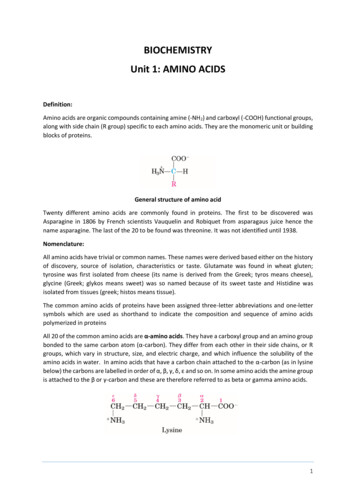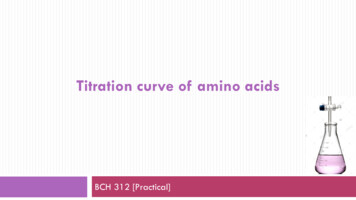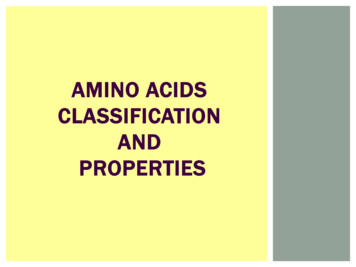
Transcription
AMINO ACIDSCLASSIFICATIONANDPROPERTIES
WHAT ARE AMINO ACIDS. Amino acids are organic compounds containingamine [- NH 2 ]carboxyl [-COOH]side chain [R group] The major key elements if amino acids are carbon,hydrogen, nitrogen, oxygen. About 500 amino acids are known (though only 20appear in the genetic code) and can be classified inmany ways
BASIC STRUCTURE[SKELETON]
NEED FOR CLASSIFICATION Classification of amino acids gives the groupingbetween 20 acids and a basic outline for grouping. It makes a clear idea to pick the amino acid type This is much useful for biochemists for the easyunderstanding between each amino acids.
Classification:Based on R group Polarity and R group Distribution in protein Nutritional requirements Number of amino and carboxylic groups
Based on R-Group Simple amino acids:these have no functional group in their sidechain.Example: glycine, valine, alanine, leucine,isoleucine Hydroxy amino acids:these have a hydroxyl group in their sidechainEg: serine, threonine
Sulfur containing amino acids:have sulfur in their side chainEg: cysteine, methionine Aromatic amino acids:have benzene ring in their side chainEg: phenylalanine, tyrosine Heterocyclic amino acids:having a side chain ring which possess atleast on atom other than carbonEg: Tryptophan, histidine, proline
Amine group containing amino acids:derivatives of amino acids in whichone of carboxyl group has been transformedinto an amide groupEg: Asparagine, glutamine Branched chain amino acids:A branched-chain amino acid (BCAA) isan amino acid having aliphatic side-chains witha branchEg: leucine, isoleucine, valine
Acidic amino acids:have carboxyl group in their side chainEg: Aspartic and Glutamic acid Basic amino acids:contain amino group in their side chainEg: Lysine, Arginine Imino acid:Amino acids containing a secondary aminegroupEg: Proline
Polarity and R Group Amino acids with non polar R group:these are hydrocarbons in nature,hydrophobic, have aliphatic and aromatic groups[aliphatic R groups]Eg: Alanine, Valine, Leucine, Isoleucine, Proline.[Aromatic groups]Eg: Phenylalanine, Tryptophan,Methionine(sulfur)
Amino acids with polar but uncharged RGroup:these amino acids are polar and possessneutral pH value.Eg: Glycine, Serine, Threonine, Cysteine,Tyrosine, Glutamine, Asparagine.
Negatively charged amino acids:their side chain [R Group] contain extracarboxyl group with a dissociable proton.And renders electrochemical behaviour toproteinsEg: Aspartic acid and Glutamic acidAspartic acid
Positively charged amino acid:their side chain have extra amino groupRendering basic nature to protein,Eg: Lysine, Arginine, Histidine.Lysine
Distribution in protein: Standard protein amino acids:the amino acids that are used to formproteins,recognized by ribozyme autoaminoacylationsystemsEg:Histidine, isoleucine, leucine, lysine, methionine,phenylalanine, threonine, tryptophan,and valine
Non standard protein amino acids:these amino acids are not required to buildproteins.have a vital role as metabolic intermediates.Eg. Hydroxyproline, Hydroxylysine,Carboxyglutamate, Diaminopimelate.
Non standard non protein amino acid:These are the derivative of amino acids andhave role in metabolism.Eg: Alpha amino butyrate, Citruline, Ornithine,beta-alanine.
Based on nutritional requirements: Essential amino acids:Essential amino acids cannot be made by thebody.As a result, they must come from food.The essential amino acids are: Arginine,histidine, isoleucine, leucine, lysine, methionine,phenylalanine, threonine, tryptophan, andvaline.
Non essential amino acids:An amino acid that can be made by humans andso is essential to the human diet.The nonessential amino acids: Alanine,asparagine, aspartic acid, cysteine,glutamic acid, glutamine, glycine, proline,serine, and tyrosine.
On basis of number of amino and carboxylicgroups:Monoamino- monocarboxylic aminoacids glycine, alanineprolinephenylalaninemethionineserine, threonine
Monoamino-dicarboxyli amino acid:Aspartic and glutamic acid
Diamino-monocarboxylic amino acids:Lysine, arginine, histidine.
Properties : Physical ColourlessCrystalline in natureTasteless[tyrosine], sweet[glycine, alanine]Melting point above 200 C Soluble in polar solvent and Insoluble in nonpolar solvent Have absorbance at 280nm
Mol wt: 100 – 50,000Dt All amino acids possess optical isomers due tothe presence of asymmetric α-carbon atoms. Some are structurally stable and stericallyhindered [Glycine] Amino acids [proteins]posses enzymaticactivities Amino acids exhibit colloidal nature anddenaturing property
Chemical properties Decarboxylation:The amino acids will undergo decarboxylationto form the corresponding “amines”. Thusamines are produced Histidine Histamine CO2 Tyrosine Tyramine CO2 Lysine Cadaverine CO2
Reaction with Ninhydrin:
Reaction with Alkalies (Salt formation): The carboxyl group of amino acids can release aH ion with the formation of Carboxylate (COO–) ions. Reaction with Alcohols (Esterification) : the amino acids is reacted with alcohol to form,“Ester”. The esters are volatile in contrast to the formamino acids.
Reaction with DANSYl Chloride:DANSYl chloride means “Dimethyl Amino NapthaSulphonyl Chloride”.When the amino acid reacts with DANSYl chloridereagent, it gives a “Flourescent DANSYl derivative Reaction with acylating agents (Acylation):When the amino acids react with “Acid chloride” andacid anhydride in alkaline medium it gives “pthaloylamino acid
Reaction with Sanger’s reagent: “1-flouro-2,4-dinitrobenzene” is calledSanger’s reagent (FDNB).sanger’s reagentreacts with α-amino acid to produce Yellowcoloured derivative, DNB-amino acid.
Reaction with Edmann’s reagent:Edmann’s reagent is “phenylisothiocyanate”. When aminoacids react with Edmann’s reagentit gives “phenyl thiohydantoic acid” finally it turns intocyclized form “Phenyl thiohydantoin” (Edmann’s derivative).
Reference : Dr. J.L. Jain – Fundamentals of Biochemistry byChand publications, New Delhi.
Amine group containing amino acids: derivatives of amino acids in which one of carboxyl group has been transformed into an amide group Eg: Asparagine, glutamine Branched chain amino acids: A branched-chain amino acid (BCAA) is an amino acid having aliphatic side-chains with a branch Eg: leucine, isoleucine, valine
